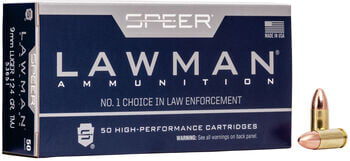
My wife is a very good athlete, and at one point held the record for the most three-point shots at the university for which she played. Early in our relationship it seemed natural to me that she would like to shoot targets at my backyard range, but things didn’t go as smoothly as I had hoped. The girl I’d seen hit a dozen mid-range baskets in a row on the court couldn’t hit slow outgoing clay targets with a 12-gauge shotgun.
When I tried to coach her and determine how on earth she could shoot so badly her response was that she was seeing two beads on the shotgun. I told her that was absurd since there was only one bead, a comment that neither helped her shooting skills nor the budding relationship.
The fact that she said she was seeing two beads confused me. How was that even possible? It wasn’t until I held a pistol left-handed sometime later that I identified the problem. When I held that gun in my left hand and tried to align the sights using my left eye something seemed to go haywire in my brain. I could see the sights with my left eye, but my right eye kept hijacking the sight picture. My girlfriend was cross-dominant, which meant her dominant hand and dominant eye were on different sides of her body. She’s not alone, either. As many as 35 percent of people are cross-dominant, and most don’t even know. But how do you know if you are cross-dominant, how will it impact your shooting, and what can you do about it?
How Cross-Dominance Works
Because your eyes are set in two different positions on your head, the information that each eye gathers is independent of the other. However, your brain cannot register information from both eyes simultaneously (you’d be seeing double all the time) and so your dominant eye takes control. If both eyes are open, the great majority of people register what their dominant eye sees.

Lawman
Train with ammunition that not only offers superb consistency but also feel and point of aim that are as close as possible to your self-defense loads. All Speer Lawman options are loaded with our exclusive TMJ bullet.
Buy NowThat process becomes complicated when there’s a pistol with iron sights in front of your non-dominant eye. Your mind is forced to interpret data sent from your non-dominant eye after a lifetime of doing just the opposite. As you might imagine, this causes issues.
How To Identify Eye Dominance
There are several ways to identify which eye is dominant, and perhaps the most common is the clock test. The clock test requires sitting across the room from an analog clock (or small television, or framed picture, or any other small object). Looking at the object with both eyes open, point your index finger at the base of the clock or similar object at the six o’clock position. From there, close one eye and then the other. The relative position of your finger to the object will remain the same when one eye is open but the relative position of your finger will change when only the other eye is open. The former is your dominant eye, the latter your weaker eye. If dominant eye and your dominant hand are on different sides of your body you are one of the 35 percent of people who are cross-dominant.

The other method of determining eye dominance is the knothole method, and to my mind it’s much simpler. Imagine if there were a board fence with a knothole in one spot that you wanted to look through. Which eye would you use? Invariably, you’ll look through the knothole with your dominant eye. It’s human nature.
If you don’t have a knothole handy you can create one using your hands. With the palms of both hands extended outward overlap your hands so that there’s only a small window visible between the thumb and index finger of both hands. Place a nearby object in the center of the “knothole,” and you’ll be looking at the object with your dominant eye. If you’re confused which eye you’re using, slowly pull your hands back toward your face, keeping the object in the center of your hands the entire time. Your hands will move toward your dominant eye.
Now What?
There are solutions to shooting accurately if you’re cross-dominant. If you’re new to shooting, the simplest answer is to simply shoot with your weak-side hand, the one that corresponds with your strong eye. I’ve had several top instructors tell me this is the solution they use. Learning to shoot with the same hand as your dominant eye will make you a more intuitive shooter which will make it easier to shoot under stressful circumstances.
Just because you’re shooting left-handed doesn’t mean you necessarily have to buy a left-handed gun. Many pistols come with ambidextrous controls (or at least reversible, but swapping the orientation of pistol controls is usually a pain). Revolvers, over-under shotguns, lever-actions and bolt-action rifles are all relatively easy to shoot left-handed when using right-handed models. If you do want a true left-handed gun, those are available from a variety of brands.
Several cross-dominant shooters have found workarounds to use their strong hand for years. If that’s the case and you aren’t interested in switching hands, there are options. Historically, the most popular method employed by trainers was to force cross-dominant shooters to use their weak eye by covering the lens of their shooting glasses with stickers or tape. It’s a horribly awkward solution, and you certainly aren’t going to tape up your glasses in the instant of a violent encounter or when a buck walks into your shooting lane.

Gold Dot Carry Gun
Subcompact confidence. This load uses our Gold Dot G2 bullet, but it’s been adapted to feed, shoot and perform better on impact through compact concealed handguns.
Buy NowYou can, of course, close your dominant eye, and I’d imagine this is the solution many shooters have learned to use (that, or rotating the head so the dominant eye is aligned with the sights). The downside is that you have to remember to shut your eye and that cuts out a substantial portion of your peripheral view. You must also always remember to close your eye if that’s the method you use—easily done on a shooting range, but not so easy to remember in a self-defense situation.
There is a trick many competition handgun shooters use for shooting stages that require weak-handed shooting, and that’s to simply rotate the pistol so that the iron sights align with the dominant eye. It’s actually a fairly simple and effective method to correct for eye dominance, though it’s not terribly effective with a long gun. In fact, it’s so effective that I shot a friendly match at Gunsite Academy in Arizona and made it to the finals only to be beaten by the venerable Sheriff Jim Wilson, a long-time law enforcement officer, gun writer, and a cross-dominant shooter who simply tilted his Browning Hi-Power to the left to accommodate for cross-dominance and proceeded to wipe the floor with me.
Takeaways
There’s a better than one-in-three chance you are cross-dominant, and if you aren’t, odds are someone you know is. Being cross-dominant isn’t ideal, but there are solutions. You can tape up your safety glass lens if you’d like, but there are better ways to shoot accurately.